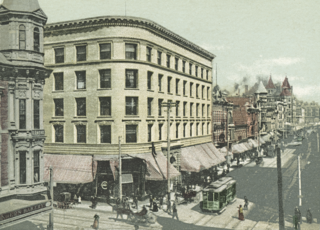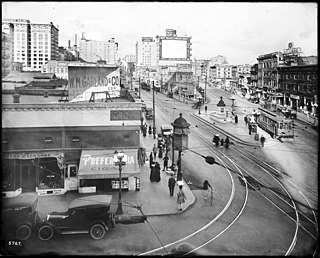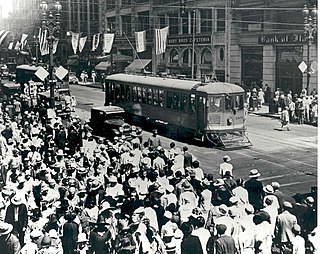History
The West 11th and Lincoln Park line began service on May 9, 1920, as a through routing of the San Pedro and W. 11th Street Line and trackage on Main Street. [1] The eastern end of the route formed a large counterclockwise loop through Lincoln Heights, [2] with the complementing clockwise service through the segment routed to the West Adams and Lincoln Park line. It was given the letter designation L in 1921. [3] [4] In August 1924 loop was eliminated, with line now running bi-directional on Mission Place and the A Line taking over tracks on Broadway. [5] That December the west end was rerouted to Spring and Ord Streets. L service took over the branch line which was built to serve the Glendale and Montrose Railway in 1925 — O and E cars initially had served been routed along the line. Tracks between Spring and Main Streets were eliminated in April 1926 to facilitate construction of the new Los Angeles City Hall. [5] The following July, service to the Glendale and Montrose Railway depot was discontinued and the line was rerouted downtown to terminate at Spring and Court Streets. Cars followed a detour on P line tracks at the end of 1927 and routed to Spring and Temple Streets following construction of the 1st Street Viaduct. [5]
On June 12, 1932, the line was rerouted downtown to terminate at Fountain Avenue and Edgemont Street [6] [7] [8] [9] — cars ceased running on Flower Street, 10th Street, Main Street, and Spring Street. Cars were briefly run through the new Hill Street Tunnel in 1939 before again being rerouted downtown. [10] [11] The final iteration of the L line began at Olympic Boulevard and Mullen Street and ended at the Civic Center, running via 10th (which was being rebuilt as Olympic), Country Club, Victoria, Hoover, 11th, Main, and Spring. The western end of the line was cut back to Menlo Avenue in April 1940, shortly before the service was discontinued on May 26. [5] [12]

Glendale–Burbank is a defunct Pacific Electric railway line that was operational from 1904 to 1955 in Southern California, running from Downtown Los Angeles to Burbank via Glendale. Short lines terminated Downtown and in North Glendale, including the popular Edendale Local.

The Pasadena Short Line was a passenger railway line of the Pacific Electric Railway. It ran between Downtown Los Angeles and Downtown Pasadena, California, through Eastside Los Angeles along the foot of the eastern San Rafael Hills to the western San Gabriel Valley. It was in service under the company between 1902 until 1951, though it had operated under different companies back to its beginnings as a horsecar line. The route, designated by the company as line 2, was the key component of the company's Northern Subdivision.

P was a streetcar line in Los Angeles, California, United States. It was operated by the Los Angeles Railway from 1895 to 1958, and by the Los Angeles Metropolitan Transit Authority from 1958 to 1963.
5 or the 5 Car was a streetcar line operated by the Los Angeles Railway, later named the Los Angeles Transit Lines, and by the Los Angeles Metropolitan Transit Authority. From 1920 to 1932, this route was known as the E Car. This was changed as part of a method to distinguish routes that lacked loops at their termini. Consequently, the 5 Car was unique during the LAMTA era in that it did not use PCC streetcars. It used buses from 1955 to 1964, transferring from LATL in 1958, then splitting the line in two in 1961, until all lines were turned over to SCRTD in August 1964.

7 was a streetcar line in Los Angeles, California. The service was operated by the Los Angeles Railway from 1932 to 1955. It ran from Spring and 2nd Streets to Athens and 116th Street, by way of Spring Street, Main Street, Broadway Place, Broadway, and Athens Way. During its Los Angeles Transit Lines days, around 1950 to 1955, Line 7 was rerouted off South Broadway to Central Avenue, at least as far north as 7th Street across Olympic Boulevard to possibly Vernon Avenue, covering trackage that was abandoned rail by line U, when that line was converted to trolley bus August 3, 1947.
8 was a streetcar line in Los Angeles, California. It was operated by the Los Angeles Railway from 1932 to 1955.
9 was a streetcar line in Los Angeles, California. It was operated by the Los Angeles Railway from 1932 to 1955.
F was a streetcar line in Los Angeles, California. It was operated by the Los Angeles Railway from 1911 to 1955.

N was a streetcar line in Los Angeles, California. It was operated by the Los Angeles Railway from 1920 to 1950. The line ran from Spring and 2nd Streets to 8th Street and Western Avenue, by way of Spring Street, 9th Street, Vermont Avenue, and 8th Street.

W was a streetcar line in Los Angeles, California. It was operated by the Los Angeles Railway (LARy) from 1895 to 1956.
The B was a streetcar line in Los Angeles, California. It was operated by the Los Angeles Railway from 1920 to 1948, originally running from Ramona Boulevard and Miller Street in East Los Angeles to Ascot Avenue and 51st Street.

U was a streetcar line in Los Angeles, California. Also referred to as the University Line, it provided service to the University of Southern California.
A refers to several streetcar routes in Los Angeles, California. The lines were operated by the Los Angeles Railway and its successor, Los Angeles Transit Lines, from 1920 to 1946.
C refers to two streetcar routes in Los Angeles, California. The lines were operated by the Los Angeles Railway from 1910 to 1932.
G refers to several streetcar routes in Los Angeles, California that ran via Griffith Avenue. The lines were operated by the Los Angeles Railway from 1910 to 1946.
O was a streetcar line in Los Angeles, California. It was operated by the Los Angeles Railway and ran until 1947.
2 was a designation given to several transit lines in Los Angeles, California. The number was assigned to a streetcar route in 1930 which lasted a year, then later reassigned to a new service in 1932. Trolley buses replaced streetcars on a 3rd line in 1948, and the line was converted to full motor coach operation in 1963.

The Echo Park Avenue Line was a Pacific Electric streetcar line in Los Angeles. The railway traveled from 11th and Hill Streets in downtown Los Angeles along the Hollywood Line to Sunset Boulevard where it turned right and proceeded north along Echo Park Avenue to terminate at Cerro Gordo Street in the Echo Park neighborhood.
K was a streetcar line in Los Angeles, California. It was operated by the Los Angeles Railway from 1913 to 1941.

M refers to several streetcar routes in Los Angeles, California. The lines were operated by the Los Angeles Railway from 1917 to 1941.








